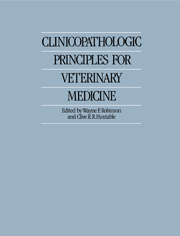Book contents
- Frontmatter
- Contents
- Contributors
- Preface
- Acknowledgements
- 1 The relationship between pathology and medicine
- 2 The immune system
- 3 The hematopoietic system
- 4 Acid–base balance
- 5 The respiratory system
- 6 The cardiovascular system
- 7 The alimentary tract
- 8 The liver and exocrine pancreas
- 9 The urinary system
- 10 The endocrine glands
- 11 The skin
- 12 The skeletal system
- 13 The nervous system
- 14 Muscle
- 15 Metabolic disease
- 16 The reproductive system
- Index
8 - The liver and exocrine pancreas
Published online by Cambridge University Press: 19 January 2010
- Frontmatter
- Contents
- Contributors
- Preface
- Acknowledgements
- 1 The relationship between pathology and medicine
- 2 The immune system
- 3 The hematopoietic system
- 4 Acid–base balance
- 5 The respiratory system
- 6 The cardiovascular system
- 7 The alimentary tract
- 8 The liver and exocrine pancreas
- 9 The urinary system
- 10 The endocrine glands
- 11 The skin
- 12 The skeletal system
- 13 The nervous system
- 14 Muscle
- 15 Metabolic disease
- 16 The reproductive system
- Index
Summary
The liver
The liver is the biochemical core of mammalian metabolism: factory, central depot, clearing house, defense unit, and waste disposal facility for the body, all rolled into one. Well over 1000 biochemical reactions take place in the liver, and its activities influence the farthest reaches of the body. In the face of this biochemical complexity, the challenge has been to identify the clinical signs and biochemical abnormalities that are relevant to the clinician. Clinicians have several tasks to hand when it has been established that liver damage is present. They must decide how significant is the damage, if it is the major cause of the clinical problem, or if it is a relatively insignificant consequence of disease elsewhere.
There is a world of difference between an animal with liver failure and an animal with some liver damage, in spite of the fact that several features might be the same in each case. The diagnosis of liver disease is now sufficiently advanced for the thorough clinician to be able to resolve these questions in most cases, in spite of the variability and nonspecificity of clinical signs. However, it is worth repeating the most important clinical concept: there is a great difference between liver damage and liver failure. This emphasis arises from the ready availability of biochemical tests which can indicate liver damage. However, positive results from such tests must be kept in perspective.
In the following paragraphs, diagnostic signposts are highlighted against the background of the normal structure–function relationships of the liver, and ultimately against underlying disease processes within liver tissue.
- Type
- Chapter
- Information
- Clinicopathologic Principles for Veterinary Medicine , pp. 194 - 215Publisher: Cambridge University PressPrint publication year: 1988
- 1
- Cited by



